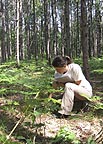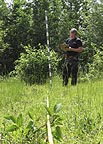September 22, 2006
Researchers assist Michigan tribe with deer study
CARBONDALE, Ill. -- Clay Nielsen often researches unpleasant interactions between people and animals. Some of the Southern Illinois University Carbondale assistant scientist's work involves investigating cougar sightings in Illinois and looking into situations where deer populations come into conflict with humans.
An ongoing project, however, finds Nielsen in the pleasant position of using his wildlife experience to protect the deep spiritual bonds between an American Indian tribe and the white-tailed deer that inhabit its lands.
Nielsen, who works with the SIUC Cooperative Wildlife Research Laboratory, is working with the Little River Band of Ottawa Indians in the northern Lower Peninsula of Michigan near the community of Manistee. Nielsen and two SIUC graduate students are helping the tribe find ways to optimize the population of deer, which hold a special place in the tribal culture.
Funding for the project comes from a $250,000 grant from the U.S. Fish and Wildlife Service. The SIUC team will work with tribal natural resource managers and researchers during the three-year project.
The graduate students, Janice Stroud of Matamoras, Pa., daughter of Joseph and Mary Beth Stroud (102 Clearstone Drive, Easley, S.C.) and Cyrus Hester, son of David Hester and Karen Salazar of Oak Forest (16131 S. Grove Ave.) spent part of this summer in the area doing initial vegetation surveys and deer population estimates. A main portion of the work is set for winter, when the SIUC team travels north to capture and fit deer with radio collars.
Researchers want to estimate the deer population and measure its impacts — positive or negative — on the tribe's forested lands. They will use the information to devise a comprehensive management plan.
As part of that effort, the researchers will develop a deer abundance-monitoring program that will allow future tracking of population trends. They also will create a population model to predict deer abundance trends and response to harvest management, and they will quantify the impact of the deer on the ecosystem by examining vegetation in the areas studied.
Although the scientific aspects of the study are important, the potential cultural impacts intrigue Nielsen. In a poll taken by the tribe's Natural Resources Department, more than 96 percent of its members indicated deer was the game animal they hunt most often while 51 percent considered deer a culturally significant species in need of increased management.
"Some of the cultural aspects to this study are really interesting," said Nielsen, adding this is the first time he's worked in such an environment. "Often I'm called to do work where there is an overabundance issue or nuisance conflicts. This is very different because we're working with people who have deep spiritual connections and reverence for these animals.
"We want to have the number of deer in balance with the desires of the tribal members. That's a challenge for anybody," Nielsen said.
The study will provide baseline information, which will reveal whether the herd is too few or too many in number. Having either too few or too many deer can lead to adverse effects for humans, both in terms of safety, impact on the ecosystem and simple wildlife viewing enjoyment.
"If deer negatively affect the forest, that affects other culturally important species," such as the black bear, Nielsen said.
The researchers will use several methods to estimate the deer population, including spotlight sampling and herd composition analysis based on age and sex of the deer. To measure ecosystem impacts, they will use vegetation "exclosures," which prevent deer from coming in contact with plants in some areas, in order to draw comparisons with nearby plants that are open to deer impacts.
The management plan will incorporate the various findings as well as maps and predictions about the herd's future and its effects on the ecosystem. It also will include various recommendations for deer harvest and forest management practices that will give the tribe options and flexibility in the future.
"The tribe will gain a much greater capacity to manage its own wildlife and habitat as a result of this project and the management plan produced," Nielsen said.
Identifying, pursuing and obtaining new sources of external grant and contract funding is among the goals of Southern at 150: Building Excellence Through Commitment, the blueprint the University is following as it approaches its 150th anniversary in 2019.

Examining habitat – Janice
Stroud, a graduate student
at Southern Illinois
University Carbondale from
Matamoras, Pa., measures the
vegetative structure in a
forest on land controlled by
the Little River Band of
Ottawa Indians this summer
in the northern Lower
Peninsula of Michigan near
the community of Manistee.
Hester is part of a team
of SIUC researchers, led
by Assistant Scientist
Clay Nielsen, helping the
tribe find ways to optimize
their population of deer,
which hold a special place
in the tribal culture.
Download Photo Here

Examining habitat – Cyrus
Hester, a graduate student
at Southern Illinois
University Carbondale from
Oak Forest, measures the
vegetative structure in a
forest on land controlled
by the Little River Band
of Ottawa Indians this
summer in the northern Lower
Peninsula of Michigan near
the community of Manistee.
Hester is part of a team
of SIUC researchers, led
by Assistant Scientist
Clay Nielsen, helping the
tribe find ways to
optimize their population
of deer, which hold a special
place in the tribal culture.
Download Photo Here
